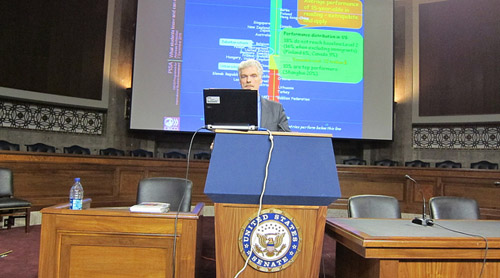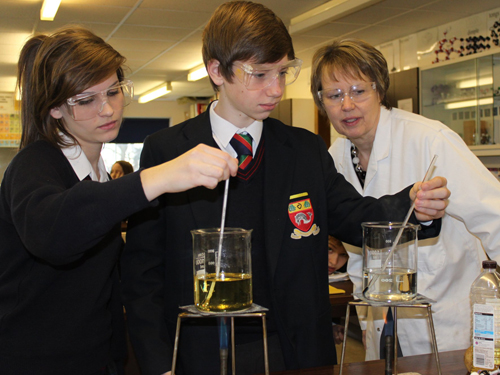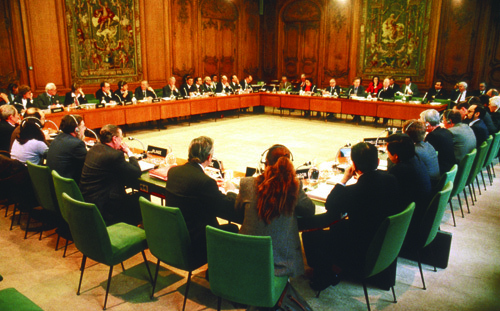
A fascinating new study reveals that students want more input in their education and specifically on the relevance of testing. El Hacer que la evaluación importe study underscores that students and teachers place less relevance on high stakes accountability assessments but agree that tests are helpful when they are meaningful to individual learning and useful to classroom instruction in K-12 education. The study also reveals that major gaps persist in teacher assessment literacy and in some cases, that alarmingly different student perceptions exist about the value of assessment based on gender, edad, racial, ethnic and family income. Finalmente, students and educators saw a positive impact in technology-based testing.
Joining me today in La Búsqueda Global para la Educación to discuss the key findings of Hacer que la evaluación importe: Students And Educators Want Tests That Support Learning, are Matt Chapman, President and CEO of NWEA (Asociación de evaluación del noroeste), Kelly Goodrich, Director of Policy and Advocacy of NWEA, and Peter Grunwald, President of Grunwald Associates.
Matt, please briefly outline the goals of this study.
As the country begins to implement common standards, and the dialogue around the purpose, frequency and delivery of testing has become increasingly heated, we sought to uncover the perspectives of students, teachers and district administrators.
We were very interested in examining the perspectives of students, whose opinions are often unsought and unheard in the development and implementation of educational policies. What we found was both surprising and, we feel, critical to consider as we move forward in developing learner-centered systems at the local, state and national level.


Peter, one concern about testing has been that test prep “interferes with learning”, es decir. teachers and students become too focused on prep for “pruebas” which is ultimately detrimental to “aprendizaje” hora. How did the study define “assessments that are student-focused and used to improve learning”?
We didn’t further define “assessments that are student-focused and used to improve learning” in the study. Our study findings indicate that students and teachers find less value or relevance in high-stakes accountability assessments that are largely used to measure aggregate student performance across states and districts, evaluate educators and programs, and compare groups of students. Estudiantes hacer want to know how they are doing as individuals–si están cumpliendo las metas de aprendizaje que son importantes para su educación, ahora y en su futuro. Ellos quieren saber lo que pueden hacer para mejorar. Los maestros quieren evaluaciones para proporcionar esta misma información sobre los estudiantes y sobre su propia práctica docente. Los estudiantes y profesores tanto quieren oportuna, resultados procesables de evaluaciones. Y los estudiantes ven a sus maestros para ayudar a monitorear su progreso y para obtener ayuda con su aprendizaje.
En nuestra opinión,, assessments that are student-focused and used to improve learning respond to these student and educator priorities. Student-focused assessments are tightly connected to learning expectations, the curriculum and teaching–and relevant to individual students. Such assessments are an integral part of instruction as it is happening, not just afterwards, to gauge student understanding during teaching moments.
Evaluación centrada en los estudiantes también significa que los estudiantes reciban los resultados de evaluación que puedan entender cuando todavía hay tiempo para poner a buen uso. Los maestros también deben trabajar con los estudiantes a utilizar los resultados de evaluación para establecer metas de aprendizaje. Y los profesores deben tener tiempo para colaborar con sus compañeros para interpretar los resultados de evaluación y utilizarlos para ajustar y diferenciar las prácticas de enseñanza basadas en las necesidades de los estudiantes identificados. En otras palabras, evaluación centrada en los estudiantes se ha incorporado en los circuitos de retroalimentación: students are assessed in the course of learning, students and teachers receive quick, actionable results, and these results serve constructive purposes to improve learning.
kelly, students clearly want to have a voice on assessment and their education. How do you propose we engage students in the decision-making process going forward?
I’d suggest talking with more students – including elementary, middle and high school students – on how they want to be engaged in these important discussions. It is vital to remember that the data that we are discussing is actually student data – students should have a voice in how their own data is used.
At a state level, perhaps state education leaders could establish a representative panel of students to engage when legislation or new policies are being discussed and planned.
On a federal level, perhaps educational assessment organizations and businesses could support a team of students to travel to Washington to help them engage with Congress and policy leaders on specific legislation and policies.


Matt, assessment literacy for teachers – clearly your study identified a problem here. What is the biggest gap you found and how would you solve the problem?
We found that teachers are very savvy when it comes to using assessments to inform instruction. According to our data, the vast majority of teachers are using assessment results to adjust instructional strategies (74%), plan and differentiate instruction for high, promedio, and low-performing students.
Sin embargo, we did identify some gaps among educators in the understanding of the different types and purposes of assessment and as well as broad agreement in the need for more pre-service preparation in assessment and time for professional collaboration around assessment results.
We see a need to provide teachers with more pre- and in-service time and resources, and more time for collaboration to maximize the benefit they can gain from assessments in their practice.
Peter, did you do any research on frequency of testing – que funciona? What is considered too much?
We did not ask respondents specifically about the frequency of testing. We did find, sin embargo, interesting trends around the perspectives of the amount of time spent on testing. En 2011, 28 percent of teachers and 29 percent of district administrators believed that students spent “just the right amount” of time on assessments. En 2013, despite the intense national dialogue on this subject, those numbers show marked increases for both groups–38 percent for teachers and 48 percent for district administrators.
Sin embargo, there are disparities about time spent preparing for and taking different kinds of assessments, with teachers (70 ciento) and district administrators (55 ciento) saying in 2013 that the focus on state accountability tests takes too much time away from learning.


kelly, why do you think a larger percentage of African American, Asian and Hispanic students believed state accountability tests are very important to their futures compared to just 47 percent of white students?
This is a compelling finding. As to why this is, that was beyond the purview of this survey, but clearly points to an opportunity for the education research community to explore the issue in greater depth. Understanding the reasons for this may well help us unlock greater outcomes for all students.
kelly, what steps need to be taken to expand technology readiness in every district?
Los estudiantes y los profesores nos permiten saber en sus respuestas a la encuesta que ven un resquicio de esperanza en la lucha para poner en práctica la tecnología en el aula, especialmente para la entrega de las evaluaciones. The early efforts, while not perfect, have allowed us to see the positive impact of technology based assessments – faster test delivery, faster delivery of results, greater student engagement – para nombrar unos pocos.
Mientras que los fondos adicionales son probablemente necesarias, tal vez podamos hacer que esto funcione de manera más eficiente mediante la creación de nuevas métricas que realmente demuestran la preparación escolar de la tecnología y los nuevos dispositivos, más allá de sólo el acceso a Internet. Cuando tenemos información clara sobre lo que se necesita, será mejor que podemos preparar un plan que define los recursos y objetivos.
This work will likely require partnerships – perhaps between very different organizations – to fund and support the implementation of this important change to our K-12 classrooms.
For more information on the Make Assessment Matter study: http://www.nwea.org/makeassessmentmatter


All photos are courtesy of NWEA
En La Búsqueda Global para la Educación, unirse a mí y reconocidos a nivel mundial los líderes de opinión, incluyendo a Sir Michael Barber (Reino Unido), DR. Michael Bloquear (EE.UU.), DR. Leon Botstein (EE.UU.), Profesor Clay Christensen (EE.UU.), DR. Linda Darling-Hammond (EE.UU.), DR. Madhav Chavan (India), El profesor Michael Fullan (Canada), El profesor Howard Gardner (EE.UU.), El profesor Andy Hargreaves (EE.UU.), Profesor Yvonne Hellman (Países Bajos), Profesor Kristin Helstad (Noruega), Jean Hendrickson (EE.UU.), Profesor Rose Hipkins (Nueva Zelanda), Profesor Cornelia Hoogland (Canada), Honorable Jeff Johnson (Canada), Señora. Chantal Kaufmann (Bélgica), DR. Eija Kauppinen (Finlandia), Secretario de Estado Tapio Kosunen (Finlandia), Profesor Dominique Lafontaine (Bélgica), El profesor Hugh Lauder (Reino Unido), Profesor Ben Levin (Canada), Señor Ken Macdonald (Reino Unido), Profesor Barry McGaw (Australia), Shiv Nadar (India), Profesor R. Natarajan (India), DR. PAK NG (Singapur), DR. Denise Papa (Estados Unidos), Sridhar Rajagopalan (India), DR. Diane Ravitch (EE.UU.), Richard Wilson Riley (EE.UU.), Sir Ken Robinson (Reino Unido), Profesor Pasi Sahlberg (Finlandia), El profesor Manabu Sato (Japón), Andreas Schleicher (PISA, OCDE), DR. Anthony Seldon (Reino Unido), DR. David Shaffer (EE.UU.), DR. Kirsten Immersive Are (Noruega), Canciller Stephen Spahn (EE.UU.), Yves Theze (Lycee Francais EE.UU.), Profesor Charles Ungerleider (Canada), Profesor Tony Wagner (EE.UU.), Sir David Watson (Reino Unido), Profesor Dylan Wiliam (Reino Unido), DR. Marcos Wormald (Reino Unido), Profesor Theo Wubbels (Países Bajos), El profesor Michael Young (Reino Unido), y el profesor Zhang Minxuan (De China) a medida que exploran las cuestiones de educación cuadro grande que todas las naciones se enfrentan hoy.
La Búsqueda Global para la Educación Comunitaria Página
C. M. Rubin es el autor de dos ampliamente leído serie en línea por la que recibió un 2011 Premio Upton Sinclair, “La Búsqueda Global para la Educación” y “¿Cómo vamos a Leer?” Ella es también el autor de tres libros más vendidos, Incluido The Real Alice in Wonderland, es el editor de CMRubinWorld, y es una Fundación Disruptor Fellow.
Siga C. M. Rubin en Twitter: www.twitter.com/@cmrubinworld






Comentarios recientes